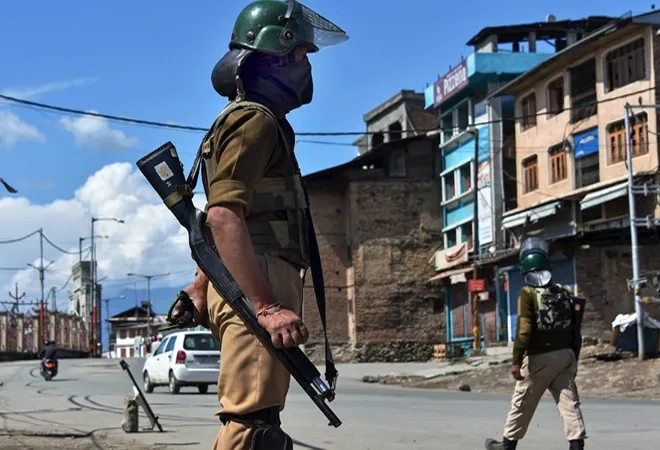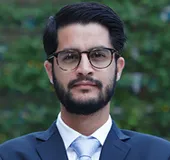
Security forces in Jammu & Kashmir are caught in a vice: The reaction to every action has led to vicious cycle of gunfights, encounters, civilian deaths and recruitment of young boys into militancy.
On 11 April, a “wise decision” had to be taken when security forces were hammered by stone pelting mobs during a gunfight in Khudwani village of South Kashmir. The intention of stone pelters was to create a scenario to allow the insurgents escape from the cordon. With four deaths, of three civilians and one Army person, the joint team of military, paramilitary, and local police had to call off the operation owing to stiff resistance which only grew stronger with each passing hour.
What made things worse was the jubilant celebrations of local populace after they succeeded in pulling out the insurgents from the spot of the gunfight. The same evening videos appeared on social media showing how hundreds of people gathered on each side of the road guarding the militants and their associates who were speeding away on motorcycles. Security forces had to yield or else the civilian casualty would rise.
Many encounters that took place this year in the Kashmir valley have led to the death of non-combatant civilians who were killed in clashes on the encounter sites. Most recently, five insurgents, including Saddam Padder, a top commander of Hizbul Mujahideen , were neutralised in an encounter at Shopian, the encounter also claimed six civilian lives.
Needless to say, each civilian death leads to further unrest and violent protests and at times a cycle in which every death causes more protests leading to more deaths. Most of the civilian deaths in violent streets protests happen in clashes with security forces during or after encounters.
Each civilian death leads to further unrest and violent protests and at times a cycle in which every death causes more protests leading to more deaths.
After every civilian death, the standard operating procedure of the police is to make sure the cycle gets broken by restricting the civilian movement in designated areas. The temporary internet blockades fuel further disenchantment against the state and security establishment.
Equally disturbing are reports of 45 fresh recruitments of young local boys into ranks of militant groups this year. This despite a dozen boys giving up the gun and returning back to the normal life. More than 30 local militants have been killed in last four months in the valley. Going by the statistics every killing of an insurgent leads to fresh recruitments in the militant ranks. Similar trends were seen last year where 126 local recruitments happened even though the Operation All Out claimed to have neutralised 210 odd militants, out of which 86 were local.
The fact that every successful encounter is causing more recruitments — the security establishment is caught between the conundrum: to kill the militants or not. If the counterinsurgency operations are momentarily halted, the militants will feel a fresh lease of confidence and start attacking the on duty and off duty security personnel, civilians and political workers thus compelling more counterinsurgency measures. If the operations continue, the cycle of violence doesn’t end.
While at present the total number of militants as per official estimates of security forces is around 250, a number quite less in comparison to the number of active insurgents in 1990s, the scale of public support that the militant groups particularly the homegrown ones enjoy is worrisome.
Almost every encounter site sees a whirlwind of protests and public anger towards the forces. Every funeral is a spectacle in itself, a show of power — of public support. Gun salutes at the militant funerals have become a common occurrence. The mother of a local militant, Saddam Padder, was seen pulling the trigger of a gun during a funeral procession where his associates were giving a gun salute to the slain militant. As usual, the videos went viral on the social media, amplifying this act of headless glorification.
A recent report of CID department of Jammu & Kashmir police noted that the massive funeral processions “romanticise and glamorise the militancy” and thus cause more recruitments. This has led to another quandary: to return the bodies of slain insurgents or not.
Returning the bodies leads massive and multiple funerals with gun salutes, where the security forces don’t even dare to venture. And if the bodies are not returned, the public wrath will be directed at the police stations and army camps. Perhaps that is why the easier option of returning the bodies and staying away from the funerals is chosen.
Returning the bodies leads massive and multiple funerals with gun salutes, where the security forces don’t even dare to venture. And if the bodies are not returned, the public wrath will be directed at the police stations and army camps.
As the situation keeps getting complex with each passing month, the elected representatives have shown timidity in reaching out to public to try and wean away the youth away from militancy. In fact, no political party is contesting the militants thus surrendering their political space to the secessionists. The mainstream parties in the state have conveniently put the ball in the court of central government and security forces to deal with the Kashmir problem.
While the political establishment is yet to see the elephant in the room or is feigning ignorance of its presence, the security establishment needs to rethink its strategy in Kashmir. There has to be a paradigm shift in the standard operating procedures of the Army, Jammu & Kashmir Police and paramilitary forces in dealing with the insurgency. Trends emerging in the last two years show the current, largely encounter centric, counterinsurgency campaign has turned into a chain reaction that only pushes people away towards the insurgency, without breaking this cycle of violence.
New approaches
India can very well adopt some effective measures, digressing from the traditional approach which hasn’t evolved much since the first phase of the insurgency began in 1990s. The French criminal-jurisprudence system has laws which deem the intention to commit a crime a crime itself thus enabling preemptive criminal investigations. The laws in France also allow the prosecution of any person remotely and even minimally involved with a terror enterprise. Bringing in new laws that can lead to the prosecution of the network of Over Ground Workers, which provides logistical support for recruitment, training and mobilisation of insurgents could help in breaking the civilian support base.
Last year, a CID report of Jammu & Kashmir police had concluded that the central jail in Srinagar had become a hub of new recruitments for terror groups. The report went on to suggest that an ecosystem had developed inside the jail to the extent that the approval for fresh recruitments came from the inmates of the jail. It has also come to light that the judiciary was lenient towards some of the arrested militants and allowed their transfer to the Central jail from other jails of the State. The ecosystem in the Central jail enabled the arrestees to take part in subversive activities as they had access to mobile phones and other facilities.
The jail system in Jammu & Kashmir fails to compartmentalise the criminals on the basis of the nature of crimes. Young boys jailed for petty crimes come in direct contact with the hardcore terrorists, often Pakistani nationals, inside the jails. These criminals are radicalised by the terrorists within the jail premises and there is no system in place to check this phenomenon.
The jail system in Jammu & Kashmir fails to compartmentalise the criminals on the basis of the nature of crimes.
The encounter centric mode of functioning in Jammu & Kashmir has left little room for building major investigative cases against the logistical networks of the militant groups. Jammu & Kashmir police is also known for notoriously arresting and detaining individuals without building evidence-based cases against them. After the Amaranth Yatra attack in South Kashmir, a thorough investigation by the Jammu & Kashmir police revealed the entire plot of the terror attack and prosecuted the civilian network which enabled the attack apart from neutralising the insurgents. However, this investigation was an exception. If at all the cases are investigated, they fail the judicial scrutiny during the trials. Necessary police reforms which ensure and equip to conduct proper investigations will ensure the fairness of the investigative system and also create deterrence by upholding the writ of the State.
In the French system, special counterterrorism judges are appointed who deal specifically with the terror-related cases and are in direct touch with the investigating agencies, intelligence units and the judiciary. This gives them a holistic understanding of the cases. Similarly, special judges can be designated to deal with the cases related to the militant groups in Kashmir which will, in turn, ensure the cases are investigated, prosecuted and followed without any fallouts.
Moreover, the narrative of “martyrdom” has glorified the insurgency to the extent that there is no dearth of fresh recruits. Again, the encounter-centric approach fails to control other factors that lead to the growth in the insurgency. In Northern Ireland, the counterinsurgency approach showed that busting the narrative of pride and glamour of martyrdom leads to deterrence. More than the combat-driven counterinsurgency campaign, the security forces and other apparatuses of the State also need to indulge in counter-narrative warfare to puncture the propaganda of the militant groups with the aim of neutralising glorification of militancy.
As long as the encounter-centric approach of the security forces continues, the cycle of violence in Kashmir will only prolong. The new insurgency has thrown up challenges which are different from those of the 90s. Counterinsurgency campaign in Jammu & Kashmir needs a tactical shift, as the traditional approach is only adding statistics to the kill list.
The views expressed above belong to the author(s). ORF research and analyses now available on Telegram! Click here to access our curated content — blogs, longforms and interviews.




 PREV
PREV


